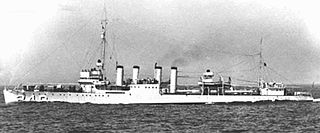
USS Jacob Jones (DD-130), named for Commodore Jacob Jones USN (1768–1850), was a Wickes-class destroyer. She was sunk by a German submarine in 1942 during World War II.

The third USS Luce (DLG-7/DDG-38) was Farragut-class guided missile destroyer of the United States Navy that served from 1962 until discarded in 1992. The ship was named for Rear Admiral Stephen B. Luce (1827–1917). Luce was sold for scrapping in 2005.

The first USS Israel (DD-98) was a Wickes-class destroyer in the United States Navy during World War I and the years following.

The first USS Maury (DD-100) was a Wickes-class destroyer in the United States Navy during World War I and the years following. She was named in honor of Matthew Fontaine Maury.

The first USS Lansdale (DD-101) was a Wickes-class destroyer in the United States Navy during World War I and later designated, DM-6 in the years following. She was named in honor of Philip Van Horne Lansdale.

USS Williams (DD-108) was a Wickes-class destroyer in the United States Navy entering service in 1919, and was the second ship to bear the name. Following a brief stint in active service, the ship was laid up for 17 years before being reactivated during World War II. Williams transferred to the Royal Canadian Navy during World War II as part of Lend-Lease and was renamed HMCS St. Clair (I65), surviving the war and being scrapped in 1946.

USS Breckinridge (DD–148) was a Wickes-class destroyer in the United States Navy during World War II, later reclassified as AG-112. She was named for Ensign Joseph Breckinridge.

The second USS Marblehead (C-11/PG-27) was a Montgomery-class unprotected cruiser in the United States Navy, authorized in the naval appropriations bill of September 7, 1888. Marblehead served in the Spanish–American War and World War I, and was the last ship of her class in service.

USS Parrott (DD-218) was a Clemson-class destroyer in the United States Navy during World War II and was the second ship named for George Fountain Parrott.

USS Fox (DD-234/AG-85) was a Clemson-class destroyer in the United States Navy during World War II. She was the fourth ship named for Gustavus Vasa Fox, Assistant Secretary of the Navy during the Civil War.

USS Kane (DD-235/APD-18) was a Clemson-class destroyer in the United States Navy during World War II. She was the first ship named for Elisha Kent Kane.

USS Sturtevant (DD-240) was a Clemson-class destroyer in the United States Navy during World War II. She was the first ship named for Albert D. Sturtevant.

The fourth USS Lawrence (DD-250) was a Clemson-class destroyer in the United States Navy during World War II. She was named for James Lawrence.

USS Isherwood (DD-284) was a Clemson-class destroyer in service with the United States Navy from 1919 to 1930. She was scrapped in 1931.

The first USS Lardner (DD-286) was a Clemson-class destroyer in service with the United States Navy from 1919 to 1930. She was scrapped in 1931.

USS Rodman (DD-456/DMS-21), a Gleaves-class destroyer, is the first ship of the United States Navy to be named for Admiral Hugh Rodman.

USS Charles H. Roan (DD-853) was a Gearing-class destroyer of the United States Navy. The ship was named after Charles Howard Roan, a United States Marine who lost his life in action on the island of Palau during World War II.

USS Ernest G. Small (DD/DDR-838) was a Gearing-class destroyer of the United States Navy, named for Rear Admiral Ernest G. Small (1888–1944).

USS Leonidas (AD-7) was a destroyer tender, the lone ship in her class, named for Leonidas I, and the second United States naval vessel to bear the name.

USS Marietta was a schooner-rigged gunboat. She was laid down by Union Iron Works, San Francisco, California, on 13 April 1896 and launched on 18 March 1897, sponsored by Mrs. C. L. More, daughter of Brigadier General T. C. H. Smith and commissioned in September 1897.




















